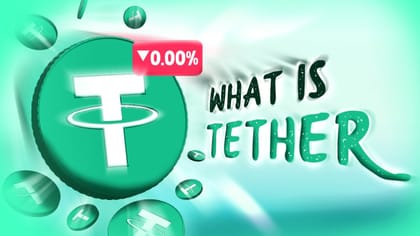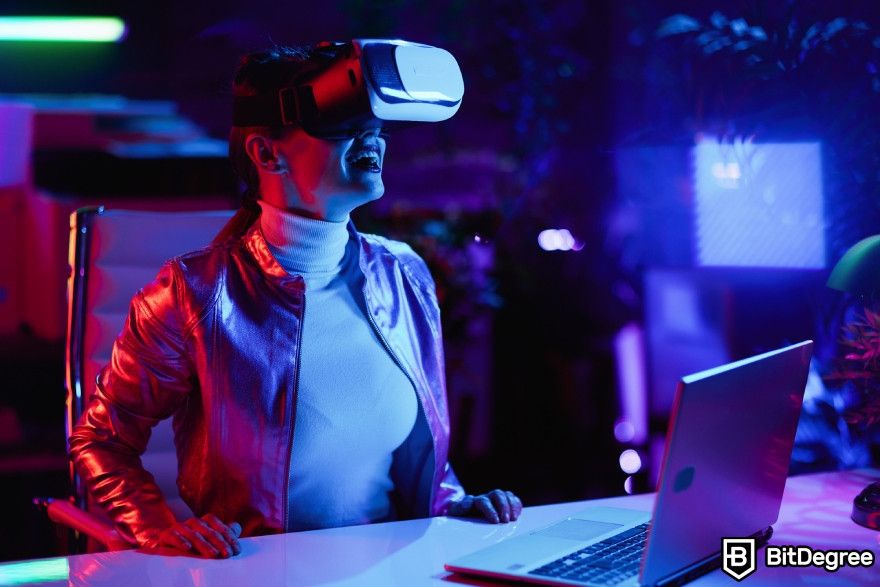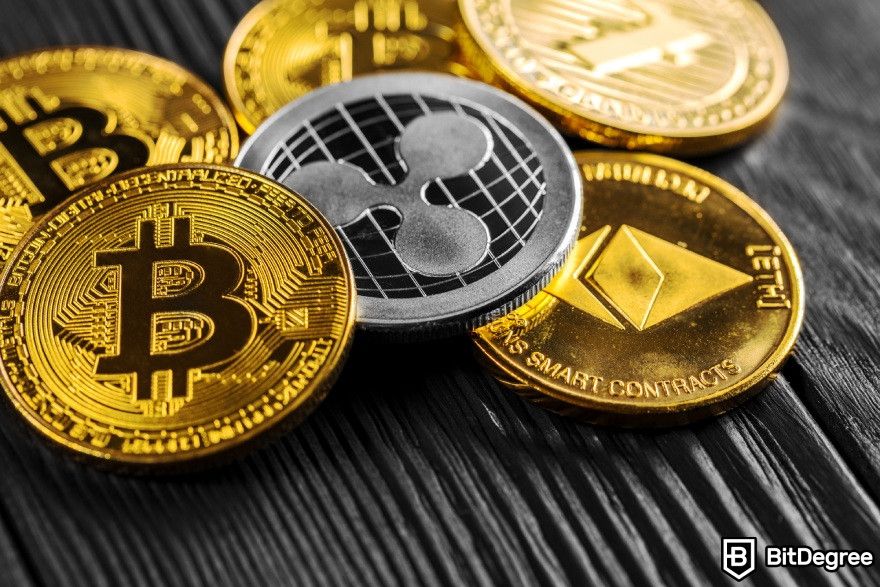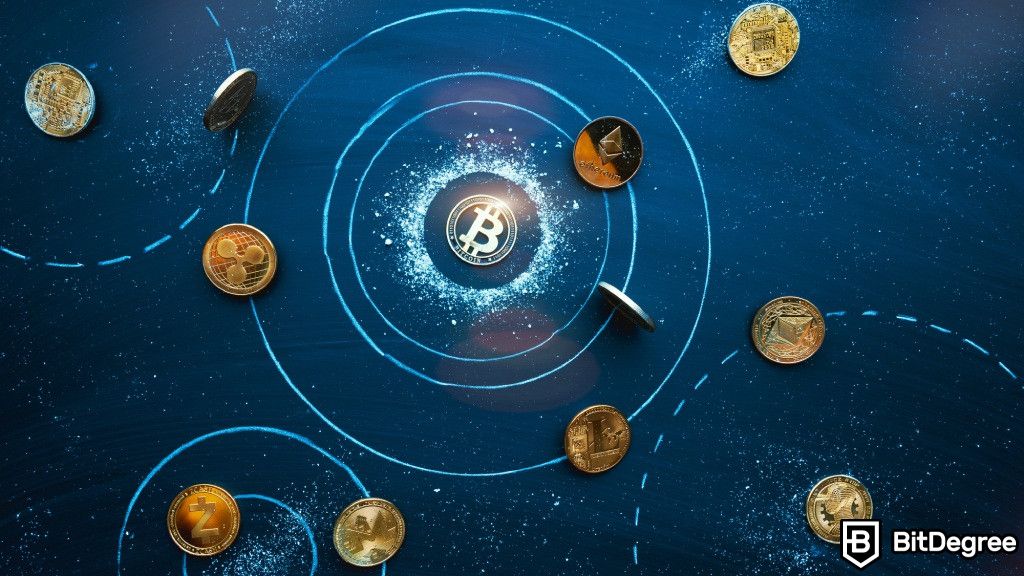Key Takeaways
- The omniverse concept extends beyond our traditional understanding of reality, encompassing not only multiple universes but also digital realms like the metaverse;
- Cryptocurrencies and blockchain technology play a crucial role in shaping the metaverse's financial landscape;
- The ties between the omniverse and the crypto world highlight the importance of interoperability and integration in digital ecosystems.
Free Airdrop Season 7 is LIVE! Answer fun questions or do simple tasks to earn rewards from the $30K BitDegree prize pool. Participate Now ! 🔥
The omniverse meaning has emerged as a captivating notion in our era of rapid technological advancements. It encompasses a vast interconnected landscape of virtual realms, immersive experiences, and expansive networks that blur the boundaries between the physical and the digital.
In the context of digital realms and interconnectivity, crypto exchanges like Binance, Bybit, and KuCoin also play a significant role. These platforms provide avenues for individuals to engage in the emerging digital economy, facilitating the exchange of cryptocurrencies and enabling users to participate in the technological omniverse.
So, let's embark on a journey to understand the meaning of the technological omniverse, exploring its origins, cutting-edge technologies, implications for our collective future, and maybe even what is beyond omniverse.

Did you know?
Subscribe - We publish new crypto explainer videos every week!
What Is Tether? (USDT SIMPLY Explained With Animations)


Table of Contents
Omniverse Meaning: Definition and Significance
The omniverse meaning represents a vast interconnected network of multiverses and metaverses, encompassing a staggering range of possibilities and dimensions. It extends beyond the confines of any individual universe, providing a framework for connecting and integrating diverse realms of existence.
Latest Deal Active Right Now:Head to BitDegree Missions, gather as many Bits as possible & claim your stake of the $30,000 Prize Pool! Don't waste your time & start collecting Bits by completing Missions and referring friends.
Before getting into further exploration of omniverse meaning, keep in mind that we can talk about omniverse in the galactic or existential sense, but we can also talk about technological omniverse where each universe is some sort of a platform or a technology. I'll touch upon both.
Brace yourself, I might get a bit philosophical.
At its core, the omniverse acknowledges the existence of multiple parallel universes known as multiverses. These multiverses can vary in their fundamental physical laws, constants, and properties, resulting in a wide array of potential realities.
Each multiverse can contain its own set of universes, all with their own unique characteristics and possibilities. In addition to the multiverse, the omniverse incorporates the concept of the metaverse. A metaverse is a virtual reality space or a collective virtual shared space that transcends individual virtual worlds.
It is a digital realm where people can interact, collaborate, and engage in various activities. Metaverses can simulate aspects of the physical world or create entirely new and imaginative environments.
The omniverse acts as a unifying framework that enables the interconnection and interaction between these diverse multiverses and metaverses. By providing a means for data transfer, technology sharing, communication, and collective endeavors across these different realms, the omniverse fosters innovation.

Imagine a scenario where individuals from different multiverses and metaverses can seamlessly communicate and collaborate on projects, irrespective of their physical or digital origins. Consequently, scientists from one "universe" can share their discoveries with counterparts from other "universes," leading to accelerated advancements.
Similarly, artists can create collaborative virtual exhibitions that span across multiple metaverses, reaching audiences from various realities. The possibilities for cross-dimensional interactions and collaborations within the omniverse are virtually limitless.
As the number of multiverses and metaverses expands, so does the scope and complexity of the omniverse. Therefore, it continuously grows in parallel with the proliferation of these interconnected realms, encompassing an ever-increasing amount of data, experiences, and possibilities.
The omniverse meaning has captivated the imagination of scientists, technologists, philosophers, and artists alike. After all, it presents a vision of a boundless interconnected reality, where the barriers between universes and virtual spaces dissolve, and the potential for exploration, discovery, and collaboration transcends.
However, it is important to note that the omniverse meaning, while intriguing and conceptually fascinating, remains speculative and theoretical in nature. Consequently, it represents a speculative extension of our understanding of the multiverse and the potential future development of metaverse technologies.

The actual realization and implementation of such a complex and interconnected system is an ongoing scientific and technological exploration. A question that might surface along the way, as the magnitude of this concept is unveiled, is “What is bigger than the omniverse?”. While the answer to that question is quite simple, it is a mutable subject.
As of writing, no widely accepted or scientifically recognized concept is considered "bigger" than the omniverse. As it is already considered an all-encompassing concept, it is difficult to conceptualize something beyond it.
However, it's worth noting that our understanding of this concept is constantly evolving. In the future, new theories or ideas may emerge that could challenge or expand our understanding of this subject. Until then, there is no way to know what is bigger than the omniverse.
For now, let's focus on what is beyond omniverse itself, in a non-literal way, turning our attention to exploring the concept of what is the omniverse theory’s origins.
By delving into the history and theories surrounding the omniverse meaning, we can gain a deeper appreciation for its significance and the ongoing quest to unravel its mysteries.
Omniverse Theory: Origins, Thinkers, and Evidence
Taking a closer look into what is the omniverse theory, we can notice that the concept itself is quite intriguing, it attempts to describe a system that could potentially produce our known universe, among other things[1].
However, it is important to note that the term "theory" in the context of what is the omniverse theory is not used in the same way it is in the natural sciences. While scientific theories are well-established explanations supported by observable evidence, the omniverse theory is more akin to mathematical frameworks and speculations.
The theory does not claim to explain the origin of the universe itself but rather proposes a system that could generate multiple universes within a broader framework. It goes beyond the scope of traditional scientific theories like relativity or evolution and doesn't seek to provide an explanation for all natural phenomena.
Instead, it presents a conceptual framework that allows for the existence of multiple universes or dimensions. Originating from speculative thinking, the theory has been explored by various thinkers, philosophers, and scientists.
While there may not be a single definitive origin for the theory, it is rooted in the human desire to understand their own nature of existence. Be it in a more literal sense or even beyond what can be directly observed.

Some of the notable thinkers who have contributed to the development of this concept include Max Tegmark, a physicist known for his work on the mathematical universe hypothesis, and Brian Greene, a theoretical physicist who has explored the concept of a multiverse in his writings.
Focusing more on Max Tegmark’s perspective on the omniverse meaning, he has put forth a fascinating perspective on the nature of reality in his book "Our Mathematical Universe"[2].
One of the key concepts he explores in his book is the omniverse itself, which encompasses the idea of a multiverse consisting of multiple universes, each with its own set of physical laws and properties.
According to Tegmark, the omniverse is structured into four infinite levels, collectively capable of containing an infinite number of observable universes. This implies that within this vast ensemble of universes, there is a high likelihood of finding a replica of our Earth.
Additionally, even more intriguing, is not only a replica but numerous alternative Earths that differ slightly from our own. In these alternate versions, subtle variations exist, such as different choices being made or events occurring in slightly different ways.
The implications of this viewpoint are truly mind-boggling. Tegmark suggests that every conceivable choice, option, combination, permutation, and variation that anyone can make at any given moment exists as a real alternate reality in some universe within the omniverse.

This notion suggests an astonishing breadth of possibilities, where every potential outcome and scenario imaginable finds a place in this grand cosmic tapestry. Moreover, Tegmark proposes that the omniverse encompasses at least 26 dimensions.
Our familiar three spatial dimensions give rise to matter, antimatter, and energy. These additional dimensions go beyond our everyday experience but play a fundamental role in the underlying structure of reality.
By presenting the concept of what is the omniverse theory, Tegmark challenges our traditional understanding of the universe and opens up a realm of speculation where the boundaries of possibility expand infinitely.
While the notion of an omniverse may seem perplexing and abstract, it provides a compelling framework, which can be used to explore the potential richness and diversity of existence beyond what we currently comprehend.
Tegmark's work invites us to contemplate the vast tapestry of reality and the myriad worlds that may be woven into its fabric. Ultimately, it encourages us to envision a universe where every choice and variation plays out across infinite dimensions, shaping the complex interconnectedness of the omniverse.
Evidence for the omniverse theory is a subject of ongoing exploration and debate. Since it deals with phenomena that may exist beyond the boundaries of our observable universe, direct empirical evidence is currently lacking.

I know I will repeat myself, but it's important to recognize that the omniverse theory is speculative in nature. As such, it is often regarded as a philosophical or conceptual framework rather than a scientific theory in the strictest sense.
While it may not adhere to the same level of formal rigor and precision as scientific theories, it can still be a valuable tool for exploring ideas and possibilities beyond the confines of our observable universe.
It can be said that to understand the omniverse meaning, is to understand that this theory offers a conceptual lens through which we can consider the broader possibilities of existence beyond our known universe.
That said, let's explore the criticisms that have emerged in response to the theory. By examining these opposing points, we can gain a comprehensive understanding of what is an omniverse, fostering a broader discussion on the nature of reality and its infinite possibilities.
Criticisms
The omniverse theory, like any speculative concept, is not immune to criticism. However, several common criticisms have been raised regarding the essence into what is an omniverse:
Lack of Empirical Evidence. One of the main criticisms of the theory is the apparent lack of empirical evidence to support its claims. Since the theory deals with phenomena beyond our observable universe, it becomes challenging to provide direct evidence or experimental verification.
Consequently, critics argue that without empirical evidence, the theory remains speculative and falls short of meeting the standards of scientific rigor. This also calls back into the question of what is bigger than the omniverse, as the lack of evidence maintains the abstract nature of this idea.
Lack of Testability. Another criticism is the limited testability of the omniverse theory. Scientific theories are typically evaluated based on their ability to make testable predictions, which can be empirically verified or falsified.
However, due to the speculative nature of what is an omniverse and the inherent difficulty in accessing or observing other universes or dimensions, it becomes challenging to design experiments or observations that can test its validity. Consequently, this lack of testability weakens its scientific credibility.
Conceptual Overreach. Some critics argue that the omniverse theory engages in conceptual overreach by attempting to explain a vast range of phenomena, including the origin of the universe and the existence of multiple universes. This, in turn, proves difficult to even imagine the concept of what is beyond omniverse.

They contend that the theory may be trying to encompass too much without sufficient grounding in empirical evidence or logical coherence, leading to potential inconsistencies or unfalsifiable claims.
Epistemic Limitations. Critics also question the epistemic limitations of the omniverse theory. Since the theory deals with concepts and entities that may lie beyond the boundaries of human perception or cognition, it could become difficult to assess a more concrete view of the theory.
Critics argue that it becomes challenging to make reliable claims or draw meaningful conclusions about the broader "omniversal" framework. As humans are confined to our own universe and have limited access to information about other possible universes or dimensions, the theory may face significant epistemic challenges.
Lack of Progress and Formal Development. Some critics suggest that the omniverse theory has not made significant progress or formal development as a scientific or mathematical framework.
They argue that it lacks the precision, coherence, and formalism necessary to qualify as a robust theoretical framework. Something comparable to well-established scientific theories or mathematical frameworks.

It's important to note that these criticisms do not necessarily dismiss the theory outright; rather, they highlight areas where it may face challenges in terms of empirical verification, testability, conceptual coherence, and formal development.
As with any speculative concept, the omniverse meaning continues to be a subject of debate and exploration within the realm of philosophy, theoretical physics, and technology.
Having examined the criticisms surrounding the theory, it is worth delving into the intriguing concept of what is an omniverse concerning another closely related idea – the multiverse.
By exploring the distinctions and potential connections between the omniverse meaning and the multiverse, we can gain a deeper understanding of the vast possibilities and complexities that underpin our evolving comprehension of both topics. So, what is the difference between the omniverse and the multiverse?
Omniverse VS Multiverse
After reaching the conclusion on what is the omniverse meaning, we can now focus our attention on a different concept – what is the difference between the omniverse and the multiverse? Well, both are concepts used to describe vast, interconnected systems of multiple realities, but they differ in terms of scale and scope.
I've already explained this a bit at the beginning of this article, but I'll now go into more detail.
The multiverse refers to the idea of multiple universes or realities coexisting simultaneously. Each universe within the multiverse may have its own set of physical laws, dimensions, and possibilities.
These universes can vary in their characteristics, such as the arrangement of matter, the values of fundamental constants, or even the presence of different forms of life. In essence, the multiverse encompasses a collection of distinct and separate universes.
On the other hand, the omniverse is a concept that goes beyond the multiverse. It represents the totality of all possible multiverses, including every conceivable variation and combination of universes and realities.

The omniverse meaning encompasses not only the known multiverses but also any hypothetical or potential multiverses that could exist. It encompasses the entire spectrum of possibilities, including different laws of physics, alternative histories, and diverse sets of rules and behaviors.
This concept is also characterized by its immense scale and complexity. It contains an unimaginable amount of data, encompassing all possible configurations and variations of reality. It is a vast network where every piece of information within each multiverse is interconnected.
In this technological context, the omniverse allows for enhanced connectivity and data transfer between different metaverses and multiverses, providing access to a vast array of information and possibilities.
In summary, while the multiverse refers to the collection of multiple universes or realities, the omniverse encompasses all possible multiverses, making it a much larger and more comprehensive concept. The omniverse represents the highest level of existence, including every conceivable variation and configuration of reality.
Omniverse VS Metaverse
Now that we are done figuring out what is the difference between the omniverse and the multiverse, it is time to unravel the intricacies between the meaning of what is omniverse and metaverse, respectively. Let's analyze both concepts while also deepening our overall understanding of the omniverse meaning.
These concepts are both related to virtual universes or interconnected digital realms, but they have distinct meanings and implications:
Scope and Inclusiveness
The omniverse, described as a verse that encompasses everything that exists, both within and beyond our understanding, includes not only the metaverse but also all universes, multiverses, and potentially other realms or dimensions. It is an all-encompassing concept that connects and incorporates various virtual (and not virtual) universes.
On the other hand, the metaverse is a specific concept within the broader framework of the omniverse. It refers to a shared virtual world that combines real and virtual elements. While the metaverse is a component of the omniverse, it focuses primarily on creating an immersive digital environment for human interactions and activities.
Function and Purpose
When it comes to the technological omniverse (I won't even try to get into the functions of the cosmic omniverse), it functions as a "platform" that connects and integrates different virtual universes and realities. It provides a framework for collaboration, simulation, and interaction between entities within these realms.

It can be utilized for various purposes, including design collaborations, digital twin simulations of real-world structures, and more.
In contrast, the metaverse primarily aims to provide a seamless and immersive virtual environment for human engagement. It strives to revolutionize how people socialize, work, learn, and interact by combining elements of the physical world with virtual reality and augmented reality technologies.
The metaverse is often associated with online social games, virtual conferences, and other virtual experiences.
Technological Emphasis
The omniverse meaning, encompassing all virtual realities, is not defined by specific technologies. Instead, it acts as a platform that can integrate different technological tools and infrastructures from various domains, such as virtual reality, augmented reality, networking, and simulation.
On the other hand, the metaverse is closely tied to cutting-edge technologies like virtual reality, augmented reality, and advanced networking infrastructure. These technologies play a crucial role in creating immersive and interactive experiences within the metaverse.
Industry Focus
The omniverse has a broad industry focus, as it can be utilized in various domains where collaboration, simulation, and interaction between virtual worlds are required. This includes fields like architecture, engineering, manufacturing, entertainment, and more.

On the other hand, the metaverse has gained significant attention from technology companies, particularly in the entertainment, gaming, and social media sectors. These industries recognize its potential to revolutionize how people engage with digital content, connect with others, and experience virtual environments.
As we know it, the concept of what is omniverse and metaverse can be viewed through numerous lenses. As done previously, in a more comparative manner or even in a more subjective manner, since the concepts themselves can be viewed abstractly.
This information serves, even if in the slightest, to prove the connection between worlds, be they big or small.
The omniverse meaning itself tries to demonstrate something almost incomprehensible. It is flexible to the point that even asking the question “What is beyond omniverse?” can be enough to unravel a mind-bending discussion on its own.
The metaverse specifically focuses on creating an immersive digital environment for human interactions, leveraging technologies like virtual reality and augmented reality.
As we transition from the discussion on the differences between the omniverse and the metaverse, an intriguing connection emerges – the tie between the omniverse and the crypto world (or, more precisely, between the crypto world and the metaverse).
The Crypto World and Its Ties to the Omniverse
The ties between the omniverse and the crypto world are forged through their interconnected nature. As you know pretty well by now, the omniverse encompasses all metaverses, creating a unified framework that allows for seamless transitions between different digital environments.
At the same time, the crypto world brings in the use of cryptocurrencies and blockchain technology, which play a crucial role in facilitating transactions, ensuring secure ownership, and enabling decentralized economies within these digital realms.
Through the integration of cryptocurrencies and NFTs, users can engage in financial transactions, purchase virtual goods and services, and participate in decentralized economies within the metaverse.
The use of blockchain technology adds an extra layer of security, transparency, and immutability to these transactions, while also reducing the risk of fraud and unauthorized access.

Additionally, the metaverse benefits from the concept of interoperability, which is often enabled by the use of blockchain technology. Interoperability allows for seamless communication and interaction between different platforms and ecosystems within the omniverse.
It enables users to transfer assets, data, and identities across various metaverses, creating a cohesive and interconnected digital experience. Moreover, the crypto world provides a means for digital asset ownership and representation.
NFTs are a prime example of this, as they allow users to claim ownership of unique digital assets such as virtual property, digital artwork, or in-game items. These NFTs can be bought, sold, and traded, providing a new dimension of value and ownership within the metaverse.
In this context, Decentraland (MANA) and The Sandbox (SAND) are a few of the leading cryptocurrencies in the metaverse space, reshaping digital platforms and rewarding users. These cryptocurrencies, along with NFTs, revolutionize digital property rights and identities.

Decentraland is a fully decentralized virtual environment, where users can buy and sell virtual land using the LAND contract, and monetize it through advertising and games. In this environment, MANA serves as the metaverse's currency for purchasing LAND, wearables, and more.
In a similar vein, The Sandbox, built on Ethereum, enables users to develop, own, and monetize gaming experiences. The SAND token facilitates transactions and is transitioning to Polygon's layer 2 solutions for improved efficiency. So, cryptocurrencies like MANA and SAND fund platform expansion and reward user engagement.
Decentraland and The Sandbox pioneer immersive metaverse experiences, shaping the future of virtual ownership and identity. Through seamless integration of crypto and NFTs, these platforms transform how we engage with virtual worlds.
Overall, the ties between the omniverse meaning and the crypto world revolve around the integration of cryptocurrencies, blockchain technology, and the concept of interoperability into the metaverse. Together, they enable secure transactions, decentralized economies, and seamless interactions within the digital realms, shaping the future of online experiences.
Conclusions
I hope that exploring the omniverse meaning has opened up new frontiers in your understanding of this unique concept. We delved into the unique view of what is omniverse and metaverse, while also not forgetting how the theory has challenged traditional notions of reality and pushed the boundaries of scientific inquiry.
While crypto exchanges like Binance, Bybit, and KuCoin revolutionize the financial landscape of the metaverse, the omniverse serves as a captivating framework that encompasses all possible universes and realms. It offers a tantalizing glimpse into the vast complexities and potential dimensions, be it in the technological sense or even the cosmic one.
As we continue to dive into this fascinating field, we can anticipate new revelations about the most exciting tech surrounding this ecosystem.
The content published on this website is not aimed to give any kind of financial, investment, trading, or any other form of advice. BitDegree.org does not endorse or suggest you to buy, sell or hold any kind of cryptocurrency. Before making financial investment decisions, do consult your financial advisor.
Scientific References
1. D. Bertolacci: 'Grand Slam Theory of the Omniverse';
2. M. Tegmark: 'Our Mathematical Universe'.
















